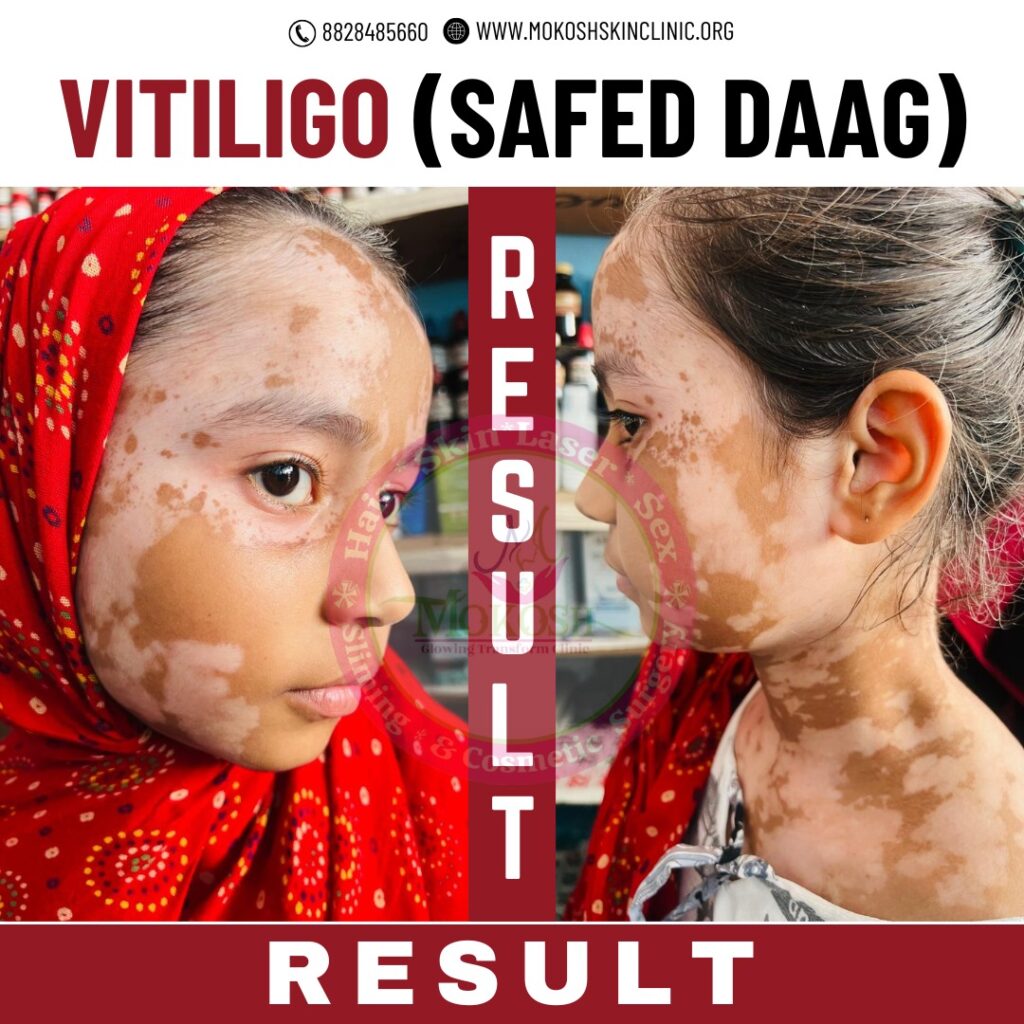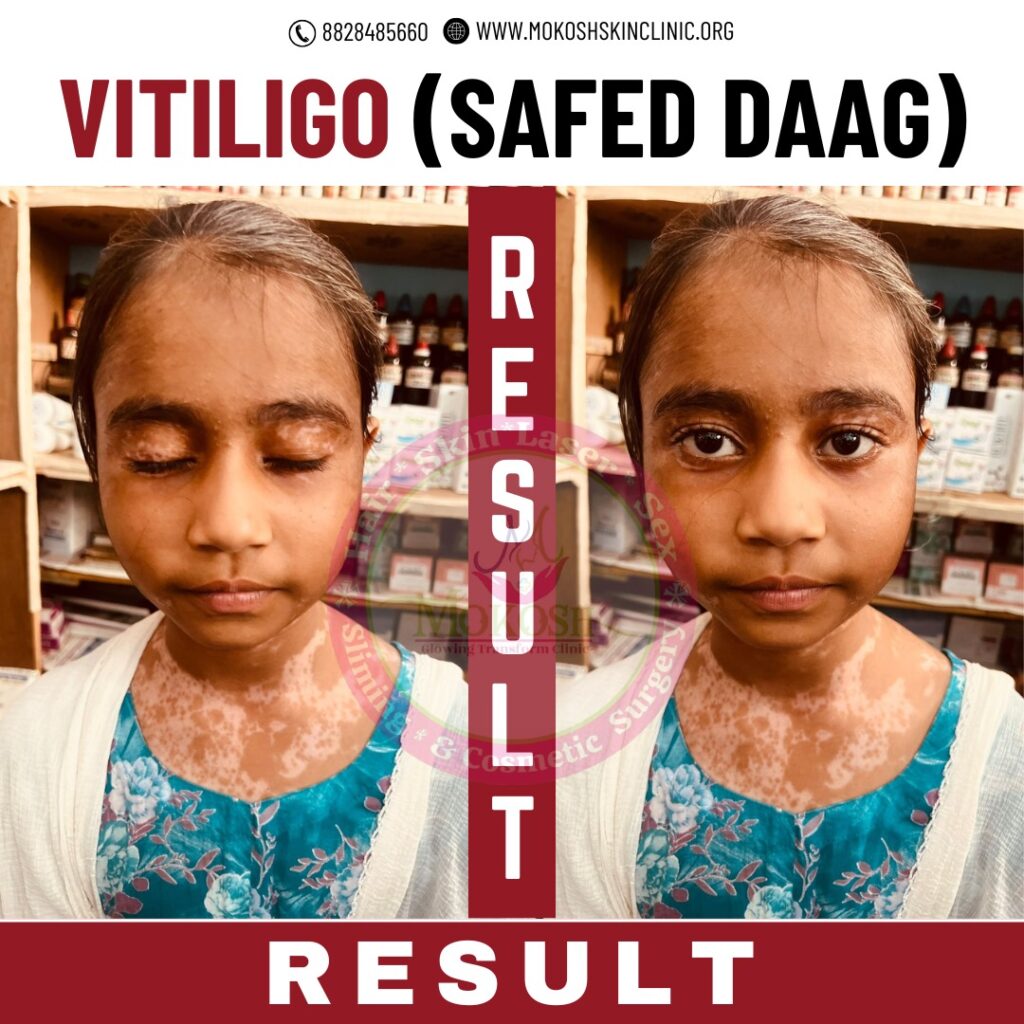Vitiligo (Safed Daag) Treatments
Vitiligo (Safed Daag) is a skin condition characterized by the loss of pigment, leading to white patches or spots on the skin. It occurs when the body’s immune system attacks the pigment-producing cells, called melanocytes, leading to the loss of melanin in certain areas. Although vitiligo can affect people of all skin tones, it often creates noticeable contrast, especially on darker skin

Vitiligo (Safed Daag) Treatment: Restore Your Skin’s Natural Tone
Vitiligo (Safed Daag) is a skin condition characterized by the loss of pigment, leading to white patches or spots on the skin. It occurs when the body’s immune system attacks the pigment-producing cells, called melanocytes, leading to the loss of melanin in certain areas. Although vitiligo can affect people of all skin tones, it often creates noticeable contrast, especially on darker skin.
While there is no permanent cure for vitiligo, there are effective treatments available that can help manage the condition and restore even skin tone. Here’s an overview of the treatments available for vitiligo and how they can help you regain your confidence.
What Are the Treatment Options for Vitiligo?
There are various approaches to Vitiligo (Safed Daag), depending on the severity of the condition, the areas affected, and your personal goals. Below are some of the most effective treatment options available today.
1. Topical Corticosteroids
What It Is: Topical corticosteroids are prescription creams or ointments that can help reduce inflammation and suppress the immune response responsible for attacking melanocytes. They can help restore pigment in the affected areas, especially when used early in the disease process.
How It Works:
- These creams are applied directly to the white patches of skin.
- Over time, corticosteroids may help promote repigmentation in areas with lost color.
Benefits:
- Non-invasive treatment.
- Can be effective, particularly for small or localized patches.
Drawbacks:
- Results can take time (several months).
- Long-term use may cause side effects like thinning of the skin.
2. Light Therapy (Phototherapy)
What It Is: Phototherapy is one of the most common treatments for vitiligo. It involves exposing the skin to controlled ultraviolet (UV) light, either through narrowband UVB or psoralen plus UVA (PUVA) therapy.
How It Works:
- Narrowband UVB therapy involves exposing the skin to UVB light in a controlled manner to stimulate pigment production.
- PUVA therapy combines a medication called psoralen (which sensitizes the skin to light) with UVA light to help repigment the affected areas.
Benefits:
- Effective for widespread vitiligo.
- Can help promote repigmentation in multiple areas at once.
- Results can be seen in a few months with regular treatments (typically 2-3 times a week).
Drawbacks:
- Treatment requires multiple sessions.
- Potential risk of skin damage or increased risk of skin cancer with long-term use.
3. Topical Immunomodulators (Tacrolimus & Pimecrolimus)
What It Is: These are non-steroidal creams that work by suppressing the immune system’s overreaction. These creams may help in the early stages of vitiligo or for people who cannot tolerate steroids.
How It Works:
- These medications are applied to the affected skin to inhibit immune cells from attacking pigment cells, helping the skin regain color.
Benefits:
- Can be an alternative for individuals who do not tolerate steroids.
- Less risk of skin thinning compared to corticosteroids.
Drawbacks:
- Results can be slow and may take several months.
- These treatments may need to be used for extended periods to see results.
4. Micropigmentation (Cosmetic Tattooing)
What It Is: Micropigmentation is a cosmetic procedure where pigment is tattooed onto the skin to match the color of the surrounding areas. This can be used to camouflage vitiligo patches, especially on areas like the face or hands.
How It Works:
- A skilled technician uses tiny needles to deposit pigment into the skin.
- This technique is particularly effective for vitiligo on small, isolated patches.
Benefits:
- Quick cosmetic solution to cover patches.
- Non-invasive and can give an immediate improvement in appearance.
Drawbacks:
- The result is temporary, as the pigment may fade over time.
- This treatment does not address the underlying cause of vitiligo, so new patches may still appear.
5. Skin Grafting and Surgery
What It Is: In some cases, when other treatments are ineffective, surgical options like skin grafting or blister grafting may be considered. This is generally reserved for more severe cases of vitiligo.
How It Works:
- In skin grafting, small sections of healthy pigmented skin are transplanted onto depigmented areas.
- In blister grafting, blisters are created on pigmented areas, and the top layer of skin is removed and transplanted onto the vitiligo patches.
Benefits:
- Can offer permanent repigmentation in some cases.
- Ideal for areas where vitiligo is stable and not actively spreading.
Drawbacks:
- Invasive and requires a recovery period.
- Risk of scarring, uneven pigmentation, or infection.
- Not suitable for all individuals.
6. Depigmentation Therapy
What It Is: For individuals with extensive vitiligo, depigmentation therapy may be considered, where the unaffected skin is lightened to match the depigmented areas.
How It Works:
- A topical medication (monobenzone) is applied to the unaffected skin to gradually lighten it until the entire body achieves a uniform appearance.
Benefits:
- Can provide a uniform appearance for individuals with widespread vitiligo.
- Ideal for people who have large areas of depigmentation.
Drawbacks:
- Permanent and irreversible, as it lightens the entire body’s skin.
- Side effects may include skin irritation.
7. Vitiligo Surgery (Stem Cell Therapy & Melanocyte Transplantation)
What It Is: Emerging treatments, like stem cell therapy and melanocyte transplantation, are being researched as advanced treatments for vitiligo. These techniques are still in the experimental stages in many areas but show promise.
How It Works:
- Melanocyte transplantation involves taking melanocytes (pigment-producing cells) from healthy areas of the skin and transplanting them into the depigmented areas.
- Stem cell therapy aims to regenerate new pigment-producing cells using stem cells, offering a potential future solution for more widespread repigmentation.
Benefits:
- Offers the potential for permanent repigmentation.
- Can be used for large areas or stable vitiligo.
Drawbacks:
- These are advanced and experimental treatments that may not be available everywhere.
- May involve long recovery times and is still undergoing studies.






